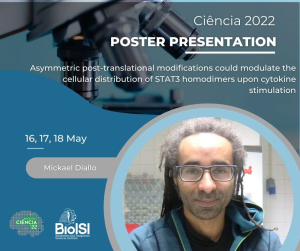BioISI Participation @ Encontro Ciência 2022
The biggest meeting of Science and Technology in Portugal – Encontro Ciência 2022 – will take place from 16 to 18 May, in Centros de Congresso de Lisboa. This event aims at contributing to the dynamization of the most important topics in the national scientific agenda and to bring together researchers, industry and the general public, and… BioISI will be there!
On May 16, José Lourenço will talk about “Climate change is increasing the transmission potential of West Nile virus in continental Portugal”, and on May 18, Jorge Marques da Silva will give a talk entitled “A Physicist, a Biologist and a Computer Scientist enter a Laboratory: Plant Phenotyping as an interdisciplinary contribution to food security in the context of climate change”.
Seven BioISI young researchers will also perform poster presentations throughout the whole event, from May 16 to 18.
On May 18, BioISI will present a demo session where participants will be able to discover our institute’s facilities.
Find out more details about the talks and the scientific posters below.
Know the meeting agenda here.
BioISI Oral Communications
Title | Climate change is increasing the transmission potential of West Nile virus in continental Portugal
Session | Ciências da Terra II, May 16, 15h30 – 17h
Presenter | José Lourenço
Authors | José Lourenço, Sílvia C. Barros, Líbia Zé-Zé, Daniel S. C. Damineli, Marta Giovanetti, Hugo C. Osório, Fátima Amaro, Ana M. Henriques, Fernanda Ramos, Tiago Luís, Margarida D. Duarte, Teresa Fagulha, Maria J. Alves, Uri Obolski
Abstract | West Nile virus (WNV) is mainly transmitted between mosquitoes and birds, but spillover into human and equine populations is possible. Most human infections are asymptomatic, but some develop severe neuroinvasive disease with associated mortality. There are currently no human vaccines nor treatments against WNV. Due to climate change favouring the geographical spread and number of mosquitoes, Europe is now witnessing an ever increasing WNV activity. In 2018, the largest epidemic ever was reported in Europe, and in 2020 Spain had its largest human epidemic to date. Although with frequently reported epidemics among equines, Portugal has so far only reported four human cases. This communication will present evidence of historical, climate-driven sustained transmission of WNV in the south of Portugal. Resorting to established computational approaches informed by satellite meteorological data of the past 40 years, it will also present evidence of climate change trends towards a warmer and dryer climate, which is slowly but steady increasing the transmission potential of WNV across the country. In light of the recent public health emergencies caused by WNV across Europe, it is only a matter of time until Portugal experiences similar events. If the country is to be prepared, it needs to urgently shift from passive to active viral surveillance. The time is now.
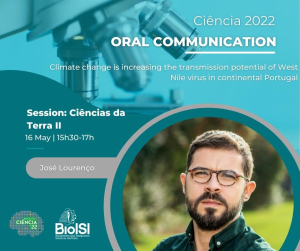
Title | A Physicist, a Biologist and a Computer Scientist enter a Laboratory: Plant Phenotyping as an interdisciplinary contribution to food security in the context of climate change
Session | Produção e Consumo Sustentáveis IV, May 18, 11h30 – 13h
Presenter | Jorge Marques da Silva
Authors | Jorge Marques da Silva, Pedro Mariano, Ana Barradas, Andrei Utkin, Guiomar Evans, Margarida Pires, José Augusto, Manuel Abreu, Miguel Costa, Nelson Saibo, Pedro Correia, Andreia Figueiredo, Anabela Bernardes da Silva, Ana Rita Matos, Conceição Proença, Juliana Melo, João Batista, Sara Silva
Abstract | Agriculture is one of the sectors most affected by climate change and also one of the largest contributors to greenhouse gas emissions. To cope with new abiotic stresses, especially heat stress and water stress, and feed the population of 10 billion expected by 2050, it is necessary to improve existing agricultural varieties. The plant breeding industry has found that the main constraint to the production of new varieties is no longer genotyping, which has instrumentation capable of doing it at high throughput, but phenotyping, which relies heavily on manual methods. Thus, an international movement has begun to develop high-throughput plant phenotyping equipment, based largely on image analysis in different spectral ranges, supported by artificial intelligence. This technology should make it possible to obtain systematic knowledge about the physiology of local cultivars, which constitute a genetic repository of high value for plant breeding. The INTERPHENO project, funded by the Foundation for Science and Technology, aims to create an interdisciplinary critical mass of experts in this area, test and improve optical techniques, develop artificial intelligence algorithms for spectra and image processing and build a high-throughput phenotyping prototype. Some of the results obtained are presented here.
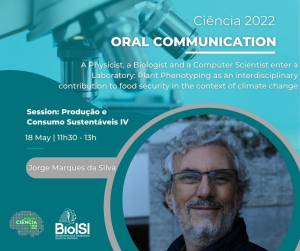
BioISI Poster Presentations
Immunity associated events in grapevine: the role of lipids and phospholipases-associated signalling
Title | Immunity associated events in grapevine: the role of lipids and phospholipases-associated signalling
Presenter | Catarina Santos
Authors | Catarina dos Santos, Gonçalo Laureano, Ana Rita Matos and Andreia Figueiredo
Abstract | Vitis vinifera L. is one of the most cultivated fruit crops in the world, being highly susceptible to Plasmopara viticola (Berk. & M.A. Curtis) Berl. & De Toni, which causes the grapevine downy mildew [1-3].With the known adverse effects of pesticides on the environment and human health, it is crucial the application of alternative techniques against this disease [2]. Phospholipases, a group of enzymes that hydrolyse phospholipids, have been reported as essential components of lipid-associated signalling to several specific biotic and abiotic stresses [4] and recent works from our team have demonstrated the role of lipid-associated signalling in grapevine response to downy mildew. Furthermore, phosphatidic acid (PA) has emerged as an essential player on plant defense mechanisms [5] and can be produced by the action of phospholipases C (PLC) and D (PLD) on membrane lipids [6] .This study provides the identification of grapevine PLC and PLD family members, their sequence characterization, as well as a nomenclature proposal, providing a basis for gene expression analyses of downy mildew infected plants.
References
[1] Figueiredo, A. et al. Transcriptional and metabolic profiling of grape (Vitis vinifera L.) leaves unravel
possible innate resistance against pathogenic fungi. J. Exp. Bot. 59, 3371–3381 (2008);
[2] Santos, R.B. et al. Grapevine– Downy Mildew Rendezvous: Proteome Analysis of the First Hours of an Incompatible Interaction. Plants 9, 1498 (2020);
[3] Gessler, C. et al. Plasmopara viticola: a review of knowledge on downy mildew of grapevine and effective disease
management. Phytopathol. Mediterr. 50, 3–44 (2011);
[4] Wang, X. Lipid signalling. Curr. Opin. Plant Biol. 7, 329–336 (2004);
[5] Laxalt, A. M. & Munnik, T. Phospholipid signalling in plant defence. Curr. Opin. Plant Biol. 5, 332–338 (2002);
[6] Wang, X. et al. Signaling functions of phosphatidic acid. Prog. Lipid Res. 45, 250–278 (2006).
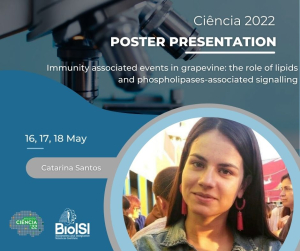
Title | The Nutritional Benefits of Grapevine Leaves
Presenter | Gonçalo Laureano
Authors | Marisa Maia, Ana R. Cavaco, Gonçalo Laureano, Jorge Cunha, José Eiras-Dias, Ana R. Matos, Bernardo Duarte, Andreia Figueiredo
Abstract | The wine industry produces an enormous amount of waste every year. Due to current demands for more sustainable agricultural practices, it is urgent to add value to this industry’s by-products. Despite being used for human consumption by some cultures, the culinary use of grapevine leaves is not widespread at a global level. In this work, we show the high potential of grapevine leaves for nutrition and as a source of bioactive compounds. Elemental, fatty acids and pigment profiles on genotypes with high economic value, were evaluated.
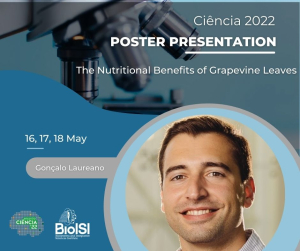
Title | Terroir: looking through a micro scale perspective
Presenter | Ana Cruz Silva
Authors | Cruz-Silva, A., Laureano, G., Gouveia, C., Pereira, M., Gama-Carvalho, M., Dias, R., Duarte, B. and Figueiredo, A.
Abstract | Grapevine is one of the most important fruit crops worldwide. In Portugal alone, 6.5 million hectoliters of wine were produced in 2021 [1]. Terroir wine is made exclusively from grapes from a specific region that comprises singular characteristics It is well established that wine sensory characteristics from a particular region are defined by the physiological responses of the grapevine to its environment and thus, the concept of terroir in viticulture was established to define the physical and biological characteristics, and the viticulture and oenological techniques of a particular place [2]. Within the factors that contribute to determine the terroirs, soil microorganisms have a major contribution, since its contribution goes beyond nutrient recycling to a drastic influence on plant fitness (growth and protection). Also, microbial activity has an especial influence in wine production and quality [3,4]. Located in the Douro valley, Quinta dos Murças is an organic vineyard from The Portuguese wine company Esporão, that harbors different terroirs differentiated by the mountains, altitude, sun exposure and the climatic characteristics. The aim of this study was to characterize the terroir associated microbiota through native long read Oxford Nanopore sequencing. This approach will allow establishing a microbial signature for each terroir.
References
[1] International Organisation of Vine and Wine, 2021 WINE PRODUCTION – OIV FIRST ESTIMATES; 2021;
[2] Van Leeuwen, C.; Seguin, G. The Concept of Terroir in Viticulture. Journal of Wine Research 2006, 17, 1–10, doi:10.1080/09571260600633135;
[3] Lonvaud-Funel, A. Lactic Acid Bacteria in the Quality Improvement and Depreciation of Wine. Antonie Van Leeuwenhoek 1999, 76, 317–331;
[4] Swiegers, J.H.; Bartowsky, E.J.; Henschke, P.A.; Pretorius, I.S. Yeast and Bacterial Modulation of Wine Aroma and Flavour. Aust J Grape Wine Res 2005, 11, 139–173, doi:10.1111/j.1755-0238.2005.tb00285.x.

Title | The secret beneath Vitis vinifera and Plasmopara viticola apoplastic communication at 6h after contact
Presenter | Joana Figueiredo
Authors | Joana Figueiredo, Rita B. Santos, Leonor Guerra-Guimarães, Céline C. Leclercq, Jenny Renaut, Lisete Sousa, Andreia Figueiredo
Abstract | Plant apoplast, the cellular compartment external to the plasma membrane including the cell wall, is the first hub of plant-pathogen communication where pathogen effectors are recognized by plant defensive proteins and cell receptors, thus activating signal transduction pathways. As a result of this first contact, the host triggers a defence response that involves the modulation of extra and intracellular proteins. In Vitis vinifera (grapevine)-pathogen interactions, little is known about the trafficking between extra and intracellular spaces. Being grapevine an economically important crop that relies on heavy fungicide use to control several diseases, a deeper knowledge on the activation of its immune response is crucial to define new control strategies. In this study, we focused on the first 6 hours post inoculation with Plasmopara viticola to evaluate grapevine proteome modulation in the apoplast. P. viticola proteome, in planta, was also assessed enabling a deeper understanding of plant-pathogen communication.
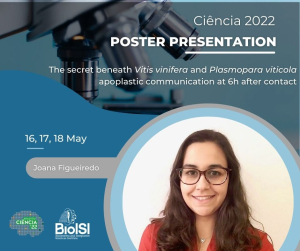
Title | Botrytis cinerea infection leads to different cell wall changes in two wine grape cultivars
Presenter | Helena Santos
Authors | Helena Santos, Cecília Rego, Pedro Reis, Jeanett Hansen, Bodil Jørgensen, John P. Moore, Ana Margarida Fortes
Abstract | Botrytis cinerea is a necrotrophic pathogen responsible for the grey mold disease. It infects diverse crops, including grapes, which leads to yeald decrease and quality reduction of the grapes and wine. It secretes enzymes to destroy the cell wall, but the mechanism is not yet fully understood at different ripening levels or different cultivars. The objective of this work is to analyse the cell wall composition and polymer matrix of grapes from Vitis vinifera Trincadeira (susceptible) and Syrah (tolerant) cultivars at different ripening stages and infection by B. cinerea.
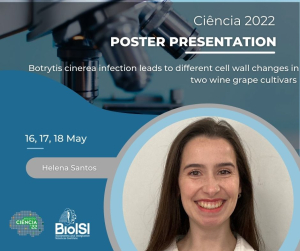
Title | Deletion of sacsin impairs intermediate filament networks and response to inflammatory cues: a possible role for glia in ARSACS
Presenter | Fernanda Murtinheira
Authors | Fernanda Murtinheira, Cristina Duarte-Olivenza, Mafalda Miguéis, Ricardo Letra-Vilela, Vanesa Martin, Carmen Rodriguez, ClaúdiaValente and Federico Herrera
Abstract | Autosomal recessive spastic ataxia of Charlevoix-Saguenay (ARSACS) is an early-onset, progressive cerebellar ataxia, involving severe axonal demyelination and Purkinje cell loss. ARSACS is caused by loss-of-function mutations in the SACS gene, which encodes sacsin, a 520 kDa protein with a function that is only partially understood. Sacsin is involved in chaperon activities, promotes the correct polymerization of neuronal intermediate filaments (i.e., neurofilaments and vimentin) and is related to mitochondrial dynamics and bioenergetics. Because the involvement of glial cells in the pathophysiology of ARSACS has not been studied to date, we proposed investigating the effects of sacsin deficiency in glial cells. We showed that sacsin is expressed at a protein level in astrocytes, C6 rat glioma cells, and N9 mouse microglia. We generated an astroglial model of ARSACS, by knocking out sacsin in C6 cells. Sacsin deletion in C6 cells induced juxtanuclear aggregation of the glial intermediate filaments glial fibrillary acidic protein (GFAP), nestin, and vimentin, along with mitochondrial depletion in that area. C6Sacs-/- cells showed impaired STAT3 signaling in response to inflammatory cytokines (i.e. Interleukin-6) and were more vulnerable to oxidative challenges (i.e. Rotenone). Our results suggest that the C6sacs-/- model could be helpful for investigating sacsin roles beyond neuronal cells in ARSACS, as well as other human pathologies triggered by disturbance of intermediate filament networks, including Alexander disease and Giant Axonal Neuropathy.
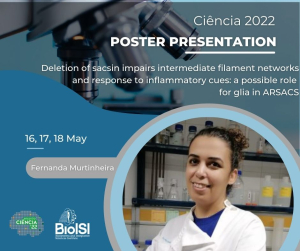
Title | Asymmetric post-translational modifications could modulate the cellular distribution of STAT3 homodimers upon cytokine stimulation
Presenter | Mickael Diallo
Authors | Mickael DIALLO, Daniela MARTINS ALVES, Ricardo LETRA-VILELA, Fernanda MURTINHEIRA and Federico HERRERA
Abstract
Aims. Signal Transducer and Activator of Transcription 3 (STAT3) is a ubiquitous and pleiotropic transcription factor involved in normal development, cell proliferation and immunity. Moreover, STAT3 is also found constitutively activated in 70% of solid cancers and associated to their chemo- and radioresistance, thus becoming a major therapeutic target. The canonical view of STAT3 activation consists in the phosphorylation of tyrosine 705, followed by dimerization, nuclear translocation and transcription of specific genes. However, STAT3 can have non-canonical functions at the mitochondria or the endoplasmic reticulum, as a monomer or as a tetramer, and it features more than 80 confirmed PTM sites. We aim at identifying relevant PTMs involved in STAT3 cell distribution and activity, with a focus on understudied residues.
Methods. We used our Venus-STAT3 bimolecular fluorescence complementation (BiFC) assay to study the subcellular localization and transcriptional activity of STAT3 homodimers where specific PTM residues were inactivated in living HeLa STAT3 knockout cells. Cellular localization of STAT3 dimers was visualized in living cells by wide-field microscopy while transcription activity was measured by flow cytometry.
Results. Resting wild-type STAT3 dimers exhibit a diffuse cytoplasmic localization, but rapidly translocate to the nucleus after incubation with Leukemia Inhibitory Factor (LIF). Phosphorylation of one STAT3 monomer at Y705 is enough for nuclear translocation of the dimers in response to LIF. Additional PTM-inactivating mutations on the Y705F monomer in asymmetric WT+Y705F dimers modulate nuclear translocation. Symmetry or asymmetry of PTM mutations have little impact on STAT3 transcriptional activity.
Conclusions. Our data suggest that asymmetric PTMs may be a new level of regulation for STAT3 activity and behavior. Our results will contribute to a better understanding of STAT3 biology and the development of new therapies against cancer.
